2020 Annual Report for: Gracillariidae / Lithocolletinae
For species seen in 2020 that had less than or equal to 100 records, full details are included; for more common species, the earliest, latest and highest count by vice-county are shown. The narrative for each species is taken from the main Hantsmoths website, and it is possible that some information on abundance and occurrence can get out of date, as it is impossible to keep up with all changes; however it should give a good introduction to each species. The tables in each species account summarise the previous status, and that for the current year.
For the maps, all records prior to 2020 are shown by a blue dot (the larger the dot, the more recent), with the current year's records shown in red. As previous records are superimposed on any report for 2020, new sites have greater emphasis (i.e. will show as 'more red').
In the species accounts, an asterisk next to a location indicates a new 10km square record; earliest ever dates are highlighted in orange, and latest ever in red. Initials in the species accounts refer to the recorders listed here. Please get in touch if you identify any omissions or errors, in particular if you have records that have yet to be submitted. Details of how to submit records can be found here.
15.034 [B&F: 0315] Phyllonorycter harrisella (Linnaeus, 1761) - Common
Common in oak woodland and areas with scattered oaks throughout Britain, widespread but apparently less frequent in Ireland. In Hampshire and on the Isle of Wight widespread and common. Wingspan 7-9 mm. Imago fairly regular at light, but more frequently recorded in the larval stage, when mines are relatively easy to find where they are present. Larva mines leaves of deciduous oaks Quercus, over-wintering as a pupa in a cocoon.
Records prior to 2020
| Vice County | #Records | #Individuals | First Record | Last Record |
|---|---|---|---|---|
| 10 | 46 | 38 | 1977 | 2019 |
| 11 | 248 | 168 | 1975 | 2019 |
| 12 | 112 | 215 | 1971 | 2018 |
2020 records
| Vice County | #Records | #Individuals | Max Quantity |
|---|---|---|---|
| 10 | 6 | 6 | 1 |
| 11 | 28 | 30 | 2 |
| 12 | 8 | 7 | 1 |
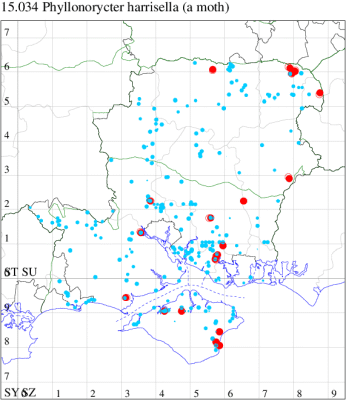
Records by year
Records by week (adult)
Records by week (larval)
Record Details
VC10: Newtown Meadows, one, field observation, 17 May; Parkhurst Forest, pupa, one, field observation, a small Pedunculate Oak had retained many leaves, several with mines, 12 Mar; Shanklin, one, 30 Jul; one, 19 Sep; Shanklin Upper Chine, one, 14 Sep; Sandown, one, field observation, 20 Apr (IOu);
VC11: Totton, one, 17 May; one, 20 May; one, 22 May; one, 09 Jul; one, 15 Jul; one, 16 Jul; two, 17 Jul; one, 21 Jul; one, 22 Jul; one, 29 Jul; one, 30 Jul; one, 07 Aug (LH); Romsey, one, 08 May; one, 09 May (NRJ); Eastleigh, one, to actinic, 08 May (KArb); Fareham, two, 08 May (IMcP); one, to actinic, gen det, 17 Jul (MLO det. RJD); one, 09 May (RJD); Wickham, one, 07 Aug (F.M.G.); Bishop's Waltham, one, field observation, 11 May; one, 12 May (DTr); Hen Wood*, one, 24 Jul (F.M.G.); Pennington, one, 29 May; one, 24 Jun; one, 07 Aug; one, 08 Aug; one, 10 Aug (RFC);
VC12: Axmansford, one, 05 Aug (ACB); Warren Hill, Liss Forest, one, 01 Aug (RJM); Castle Bottom NNR, present, netted, 18 May; Up Green Wood, Eversley*, one, netted, ♀, gen det, 07 May; one, netted, ♂, gen det, 07 May (JHH det. AMD); Farnborough, one, 30 Jul (KBW); Yateley*, one, 09 May; one, 21 May (JHH)
15.036 [B&F: 0317] Phyllonorycter heegeriella (Zeller, 1846) - Common
Common in oak woodland and areas with scattered oak trees throughout England, Wales and Scotland, except in the far north; commonest in southern England but rare in Ireland. Although not recorded in Hampshire until 1976, it is now widespread; first recorded on the Isle of Wight in 2005. Wingspan 6.5-7.5 mm. Similar to P. tenerella, which lacks the distinctly dark-bordered basal streak, although it occasionally has an ochreous base to the wing with a white central streak extending through this coloration (MBGBI Vol 2). Imago fairly regular at light, but more frequently recorded in the larval stage, when mines are relatively easy to find where they are present. Larva mines leaves of deciduous oak Quercus, over-wintering as a pupa in a cocoon.
Records prior to 2020
| Vice County | #Records | #Individuals | First Record | Last Record |
|---|---|---|---|---|
| 10 | 10 | 4 | 2005 | 2017 |
| 11 | 94 | 30 | 1972 | 2017 |
| 12 | 61 | 15 | 1971 | 2018 |
2020 records
| Vice County | #Records | #Individuals | Max Quantity |
|---|---|---|---|
| 12 | 3 | 2 | 1 |
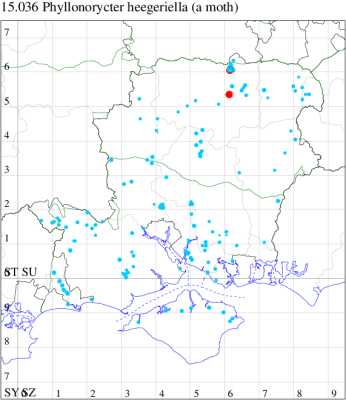
Records by year
Records by week (adult)
Records by week (larval)
Record Details
VC12: Basingstoke, one, 24 Jun; one, 26 Jun (MJW); Pamber Forest, mine, present, in oak leaf, 27 Oct (GJD)
15.039 [B&F: 0320] Phyllonorycter quercifoliella (Zeller, 1839) - Common
Common in oak woodland and areas with scattered oaks throughout much of the British Isles, except for the Northern Isles. In Hampshire and on the Isle of Wight widespread and locally common to abundant, but perhaps declining. Wingspan 7-9 mm. Similar to P messaniella, in which the basal streak barely reaches middle of wing, terminating well before the apices of the first pair of strigulae. In P quercifoliella the apical streak extends to almost two-thirds and terminates slightly beyond the apices of the first pair of strigulae (MBGBI Vol 2). Imago fairly regular at light, but more frequently recorded in the larval stage, when mines are relatively easy to find where they are present. Larva mines leaves of deciduous oaks Quercus, over-wintering as a pupa in a cocoon.
Records prior to 2020
| Vice County | #Records | #Individuals | First Record | Last Record |
|---|---|---|---|---|
| 10 | 73 | 25 | 1947 | 2019 |
| 11 | 125 | 106 | 1968 | 2019 |
| 12 | 85 | 91 | 1971 | 2019 |
2020 records
| Vice County | #Records | #Individuals | Max Quantity |
|---|---|---|---|
| 10 | 5 | 7 | 2 |
| 11 | 2 | 2 | 1 |
| 12 | 3 | 2 | 1 |
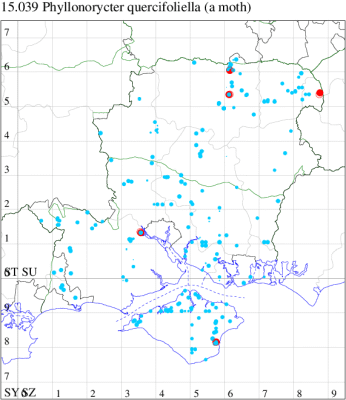
Records by year
Records by week (adult)
Records by week (larval)
Record Details
VC10: Shanklin, one, gen det, 11 Apr; two, 21 Apr; two, 09 May; one, 28 May; one, 24 Jun (IOu);
VC11: Totton, one, 01 Aug; one, 22 Aug (LH);
VC12: Basingstoke, one, 31 Jul (MJW); Pamber Forest, mine, present, on oak leaf, 17 Oct (GJD); Farnborough, one, 23 Jun (KBW)
15.040 [B&F: 0321] Phyllonorycter messaniella (Zeller, 1846) - Common
Common in woodland throughout much of the British Isles, more numerous in the south. Abundant in Hampshire and on the Isle of Wight. Wingspan 7-9 mm. Very similar to P quercifoliella, which see for differences. Although the imago is fairly regular at light, just as likely to be recorded in the larval stage, when mines are relatively easy to find where they are present. Larva mines leaves of Oak, especially Evergreen Oak, Hornbeam, Beech and Sweet Chestnut.
Records prior to 2020
| Vice County | #Records | #Individuals | First Record | Last Record |
|---|---|---|---|---|
| 10 | 232 | 831 | 1974 | 2019 |
| 11 | 1113 | 1374 | 1971 | 2019 |
| 12 | 76 | 43 | 1976 | 2018 |
2020 records
| Vice County | #Records | #Individuals | Max Quantity |
|---|---|---|---|
| 10 | 5 | 16 | 13 |
| 11 | 27 | 27 | 3 |
| 12 | 2 | 1 | 1 |
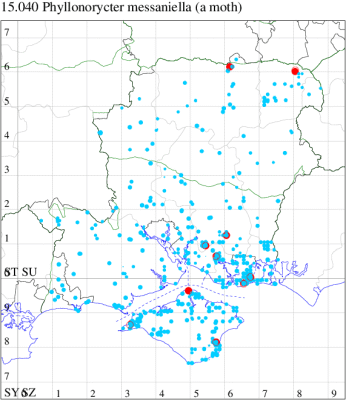
Records by year
Records by week (adult)
Records by week (larval)
Record Details
VC10: Totland, one, 18 Sep; 13, 20 Sep (RTe); Cowes, mine, present, several on Holm Oak, 25 Sep (KRy); Shanklin, one, gen det, 05 Apr; one, 14 Oct (IOu);
VC11: Botley Wood, one, 18 Sep (F.M.G.); Fareham, one, to actinic, 08 Aug; one, to actinic, 08 Nov (MLO); Portsmouth, one, 25 Jun; one, 22 Oct; one, 26 Oct (IRT); West Walk, mine, one, tenanted mine on sweet chestnut, 23 Jun; mine, three, mines on sweet chestnut, 28 Sep (RJD); Southsea, one, 16 Apr; one, 22 Apr; one, 09 Nov; one, 10 Nov; one, 13 Nov (JRL); Milton, mine, present, a few, Fagus, 06 Feb; mine, present, a few, Fagus, 06 Nov (JRL, IRT);
VC12: Pamber Forest, vacated mine, present, in sweet chestnut leaf, 18 Oct (GJD); Yateley*, one, ♂, gen det, 31 Jul (JHH det. AMD)
15.041 [B&F: 0321a] Phyllonorycter platani (Staudinger, 1870) - Local
Local in parks and urban areas, discovered new to Britain in London in 1990, since when it has spread through the southern counties of the UK and has reached the West Country and Midlands. Found in Hampshire for the first time in 1998 in Southampton and on the Isle of Wight in 2004, becoming more frequent and widespread. Wingspan 9-10.5 mm. Imago seldom encountered at light, and more likely to be recorded in the larval stage, when mines are relatively easy to find where they are present. Larva mines leaves of London Plane in late autumn and are large and obvious, one leaf often hosting several, over-wintering as a pupa in a cocoon.
Records prior to 2020
| Vice County | #Records | #Individuals | First Record | Last Record |
|---|---|---|---|---|
| 10 | 28 | 324 | 2004 | 2019 |
| 11 | 94 | 1764 | 1998 | 2019 |
| 12 | 19 | 76 | 2002 | 2019 |
2020 records
| Vice County | #Records | #Individuals | Max Quantity |
|---|---|---|---|
| 10 | 3 | 0 | 0 |
| 11 | 2 | 100 | 100 |
| 12 | 1 | 1 | 1 |
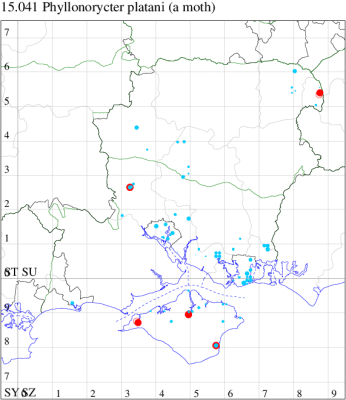
Records by year
Records by week (adult)
Records by week (larval)
Record Details
VC10: Freshwater*, larva, present, field observation, several underside mines, with larvae, on leaves of Platanus sp, 12 Sep (PBa); Newport, mine, present, numerous vacated mines in Platanus sp, 21 Jul; Shanklin, mine, present, on Planus, 26 Oct (IOu);
VC11: Mottisfont Abbey, mine, 100, mines common on both species of plane, 01 Oct (RJD);
VC12: Farnborough, one, 31 Jul (KBW)
15.043 [B&F: 0323] Phyllonorycter oxyacanthae (Frey, 1856) - Common
Common in hedgerows and woodland throughout much of the British Isles. Abundant in Hampshire and on the Isle of Wight. Wingspan 6-8 mm. This species, P. sorbi and P. mespilella cannot be separated on the basis of wing characteristics alone, however, P. sorbi, is generally larger and most specimens of P. mespilella lack the white patch on the dorsum beneath the basal streak (MBGBI Vol 2). Imago fairly regular at light, but more frequently recorded in the larval stage, when mines are relatively easy to find where they are present. Larva mines leaves of Hawthorn, Pear and Quince, over-wintering as a pupa in a cocoon.
Records prior to 2020
| Vice County | #Records | #Individuals | First Record | Last Record |
|---|---|---|---|---|
| 10 | 74 | 30 | 1926 | 2017 |
| 11 | 351 | 272 | 1969 | 2019 |
| 12 | 104 | 49 | 1975 | 2019 |
2020 records
| Vice County | #Records | #Individuals | Max Quantity |
|---|---|---|---|
| 10 | 1 | 0 | 0 |
| 11 | 2 | 4 | 3 |
| 12 | 2 | 0 | 0 |
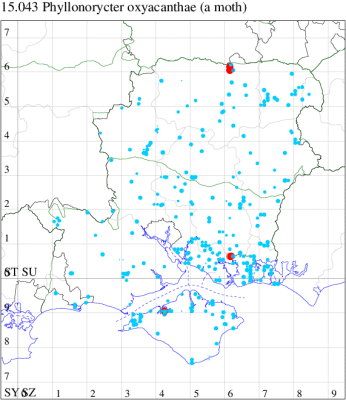
Records by year
Records by week (adult)
Records by week (larval)
Record Details
VC10: Newtown, mine, present, several on hawthorn, 26 Sep (KRy);
VC11: Portsdown, mine, three, on hawthorn undersides, 14 Sep; mine, one, in hawthorn leaf underside, 14 Sep (RJD);
VC12: Pamber Forest, vacated mine, present, on Hawthorn, 17 Oct; vacated mine, present, on Hawthorn, 18 Oct (GJD)
15.044 [B&F: 0324] Phyllonorycter sorbi (Frey, 1855) - Common
Common in woodland throughout much of the British Isles, more numerous in the north. In Hampshire fairly common in the south and north-east, but largely absent elsewhere. First recorded on the Isle of Wight at Parkhurst Forest in 1997, but not since. Wingspan 7.5-8.5 mm. Similar to P. oxyacanthae, which see for differences. Imago seldom seen at light and more frequently recorded in the larval stage, when mines are relatively easy to find where they are present. Larva mines leaves of Rowan and Bird Cherry, over-wintering as a pupa in a cocoon.
Records prior to 2020
| Vice County | #Records | #Individuals | First Record | Last Record |
|---|---|---|---|---|
| 10 | 6 | 10 | 1997 | 2017 |
| 11 | 63 | 24 | 1985 | 2019 |
| 12 | 23 | 8 | 1976 | 2019 |
2020 records
| Vice County | #Records | #Individuals | Max Quantity |
|---|---|---|---|
| 11 | 1 | 3 | 3 |
| 12 | 1 | 0 | 0 |
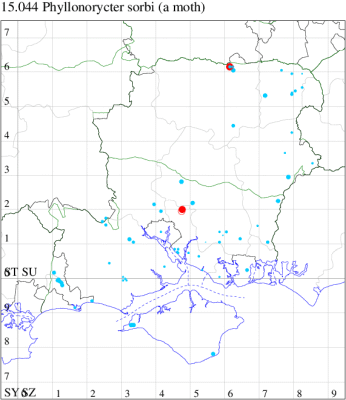
Records by year
Records by week (adult)
Records by week (larval)
Record Details
VC11: Bishopstoke, mine, three, on Sorbus sp, 05 Nov (DHu);
VC12: Pamber Forest, vacated mine, present, on Rowan leaf, 18 Oct (GJD)
15.045 [B&F: 0325] Phyllonorycter mespilella (Hübner, [1805]) - Nationally Scarce B
Nationally scarce (Nb) in woodland throughout much of England, southern Wales and eastern Ireland. In Hampshire and on the Isle of Wight like the foodplant, very rare, and restricted to just a handful of sites. Wingspan 6-8 mm. Similar to P. oxyacanthae, which see for differences. Imago rarely seen at light, and more likely to be recorded in the larval stage. Larva mines leaves of Wild Service-tree, over-wintering as a pupa in a cocoon.
Records prior to 2020
| Vice County | #Records | #Individuals | First Record | Last Record |
|---|---|---|---|---|
| 10 | 4 | 5 | 1973 | 2004 |
| 11 | 2 | 0 | 1988 | 2013 |
| 12 | 6 | 2 | 2002 | 2019 |
2020 records
| Vice County | #Records | #Individuals | Max Quantity |
|---|---|---|---|
| 12 | 1 | 0 | 0 |
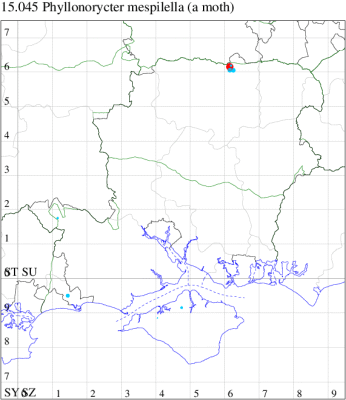
Records by year
Records by week (adult)
Records by week (larval)
Record Details
VC12: Pamber Forest, mine, present, in Wild Service Tree leaf, 18 Oct (GJD)
15.046 [B&F: 0326] Phyllonorycter blancardella (Fabricius, 1781) - Common
Common in woodland, orchards and gardens in southern England and Wales, rare elsewhere in the British Isles. Probably under-recorded in Hampshire and on the Isle of Wight, where the extent of known records correlate with those areas in which the recording effort is concentrated. Wingspan 6-8.5 mm. Similar to P. hostis, from which only reliably separated by dissection of the genitalia. Imago fairly regular at light, but more frequently recorded in the larval stage, when mines are relatively easy to find where they are present. Larva mines leaves of Crab Apple and Apple, over-wintering as a pupa in a cocoon.
Records prior to 2020
| Vice County | #Records | #Individuals | First Record | Last Record |
|---|---|---|---|---|
| 10 | 32 | 35 | 1926 | 2017 |
| 11 | 89 | 73 | 1969 | 2018 |
| 12 | 23 | 20 | 1994 | 2015 |
2020 records
| Vice County | #Records | #Individuals | Max Quantity |
|---|---|---|---|
| 10 | 2 | 1 | 1 |
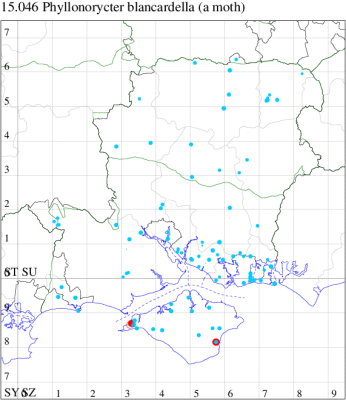
Records by year
Records by week (adult)
Records by week (larval)
Record Details
VC10: Totland, one, 18 Sep (RTe); Shanklin, present, field observation, leaf mine collected and examined, 04 Jul (IOu)
15.049 [B&F: 0329] Phyllonorycter spinicolella (Zeller, 1846) - Common
Common in hedgerows and scrubland throughout much of the British Isles, as far north as Perthshire. In Hampshire and on the Isle of Wight widespread and common especially in the south-east, but largely absent from the New Forest. Wingspan 6.5-7.5 mm. Similar to P. cerasicolella, from which separated only by dissection of the genitalia. Imago rarely recorded at light, and more frequently recorded in the larval stage, when mines are relatively easy to find where they are present. Larva mines leaves of Blackthorn and Wild Plum.
Records prior to 2020
| Vice County | #Records | #Individuals | First Record | Last Record |
|---|---|---|---|---|
| 10 | 53 | 49 | 1975 | 2019 |
| 11 | 191 | 151 | 1969 | 2019 |
| 12 | 60 | 36 | 1980 | 2011 |
2020 records
| Vice County | #Records | #Individuals | Max Quantity |
|---|---|---|---|
| 11 | 1 | 0 | 0 |
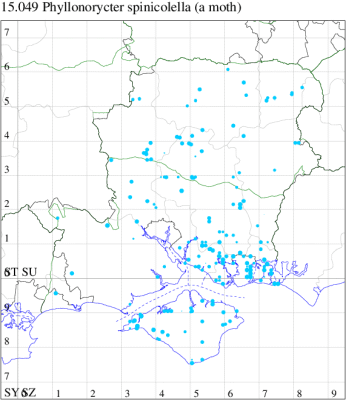
Records by year
Records by week (adult)
Records by week (larval)
Record Details
VC11: Portsmouth, mine, present, several, Prunus spinosa, 23 Oct (JRL, IRT)
15.050 [B&F: 0330] Phyllonorycter cerasicolella (Herrich-Schäffer, 1855) - Local
Local in woodland and orchards throughout southern England, north to Yorkshire. In Hampshire and on the Isle of Wight widely distributed, but not particularly common. Wingspan 7-8 mm. Cannot be distinguished on external characteristics from P. spinicolella. Imago seldom encountered at light, and more likely to be recorded in the larval stage, when mines are relatively easy to find where they are present. Larva mines leaves of Wild Cherry and Dwarf Cherry.
Records prior to 2020
| Vice County | #Records | #Individuals | First Record | Last Record |
|---|---|---|---|---|
| 10 | 12 | 12 | 1977 | 2017 |
| 11 | 50 | 20 | 1981 | 2018 |
| 12 | 15 | 19 | 1995 | 2011 |
2020 records
| Vice County | #Records | #Individuals | Max Quantity |
|---|---|---|---|
| 10 | 2 | 2 | 1 |
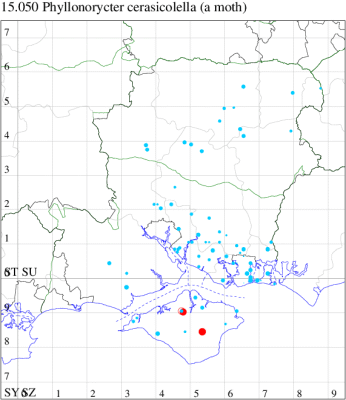
Records by year
Records by week (adult)
Records by week (larval)
Record Details
VC10: Parkhurst Forest, mine, one, underside mine on leaf of Prunus avium, 24 Sep (PBa); Merstone*, mine, one, on Blackthorn, 27 Sep (KRy)
15.051 [B&F: 0331] Phyllonorycter lantanella (Schrank, 1802) - Local
Local in hedgerows and open woodland, on calcareous soils, south of a line from the Severn estuary to The Wash. In Hampshire and on the Isle of Wight frequent on the chalk. Wingspan 8-9 mm. Adult can be separated from other Phyllonorycter species on external features only with great care, and most frequently recorded as leaf mine. Larva mines leaves of Wayfaring-tree and Guelder-rose.
Records prior to 2020
| Vice County | #Records | #Individuals | First Record | Last Record |
|---|---|---|---|---|
| 10 | 55 | 40 | 1900 | 2017 |
| 11 | 71 | 88 | 1973 | 2019 |
| 12 | 38 | 21 | 1975 | 2016 |
2020 records
| Vice County | #Records | #Individuals | Max Quantity |
|---|---|---|---|
| 10 | 1 | 0 | 0 |
| 12 | 2 | 1 | 1 |
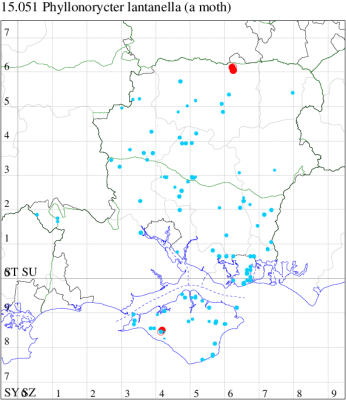
Records by year
Records by week (adult)
Records by week (larval)
Record Details
VC10: Brighstone Forest, vacated mine, present, several on leaves of Viburnum lantana, 16 Sep (PBa);
VC12: Pamber Forest*, one, 15 Aug; mine, present, on wayfaring tree leaf, 28 Oct (GJD)
15.052 [B&F: 0332] Phyllonorycter corylifoliella (Hübner, 1796) - Common
Common in scrubland, hedgerows and open woodland throughout much of the British Isles. Abundant in Hampshire and on the Isle of Wight. Wingspan 8-9 mm. Not often recorded at light, and more frequently recorded in the larval stage, when mines are relatively easy to find where they are present. Larva mines leaves of Hawthorn, Apple, Rowan, Cotoneaster and Birch, over-wintering as a pupa in a cocoon.
Records prior to 2020
| Vice County | #Records | #Individuals | First Record | Last Record |
|---|---|---|---|---|
| 10 | 117 | 45 | 1900 | 2017 |
| 11 | 420 | 329 | 1969 | 2019 |
| 12 | 118 | 30 | 1971 | 2019 |
2020 records
| Vice County | #Records | #Individuals | Max Quantity |
|---|---|---|---|
| 10 | 6 | 1 | 1 |
| 11 | 9 | 51 | 20 |
| 12 | 3 | 1 | 1 |
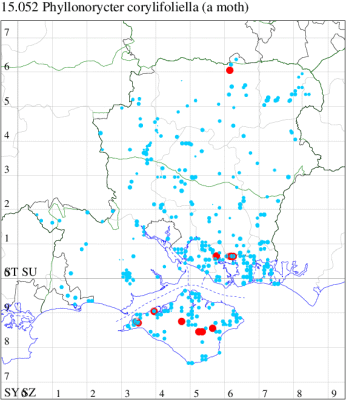
Records by year
Records by week (adult)
Records by week (larval)
Record Details
VC10: Freshwater, mine, present, upperside mines on leaves of Crataegus monogyna, 12 Sep; Cranmore, mine, present, upperside mines on leaves of Crataegus monogyna, 23 Sep (PBa); Plaish, mine, one, on hawthorn, 26 Sep; Merstone, mine, present, several on hawthorn, 27 Sep; mine, present, several on hawthorn, 27 Sep (KRy); Newchurch, mine, present, upper surface mine on Crataegus monogyna leaves, 17 Sep (PBa);
VC11: Fareham, vacated mine, one, on Hawthorn, 02 Aug (MLO); Portsdown, mine, 20, mines at all stages, though few folded up, on hawthorn uppersides, 14 Sep; mine, 20, mines common in hawthorn leaf uppersides, 14 Sep; Portchester Common SSSI, mine, 10, mines common in hawthorn leaf uppersides, 14 Sep (RJD);
VC12: Cholderton, one, 17 Jul (TJN, HE); Pamber Forest, mine, present, on Hawthorn, 17 Oct (GJD)
15.053 [B&F: 0332a] Firethorn Leaf Miner Phyllonorycter leucographella (Zeller, 1850) - Common
Common in gardens, woodland and parkland throughout much of Britain. Thoroughly naturalised, through accidental introduction in garden plants, the first British record of this adventive species was in Essex in 1989, since when it has spread rapidly northwards to Yorkshire. It was first discovered in Hampshire in early 1998, but probably under-recorded in the county and on the Isle of Wight, where the extent of known records correlate with those areas in which the recording effort is concentrated. Wingspan 6.5-8.5 mm. Imago fairly regular at light, but just as likely to be recorded in the larval stage, when mines are relatively easy to find where they are present. Larva mines leaves of Firethorn, Hawthorn, Apple, Rowan and Whitebeam.
Records prior to 2020
| Vice County | #Records | #Individuals | First Record | Last Record |
|---|---|---|---|---|
| 10 | 77 | 200 | 2001 | 2018 |
| 11 | 379 | 446 | 1998 | 2019 |
| 12 | 113 | 1140 | 1998 | 2019 |
2020 records
| Vice County | #Records | #Individuals | Max Quantity |
|---|---|---|---|
| 10 | 2 | 2 | 1 |
| 11 | 13 | 9 | 1 |
| 12 | 7 | 9 | 3 |
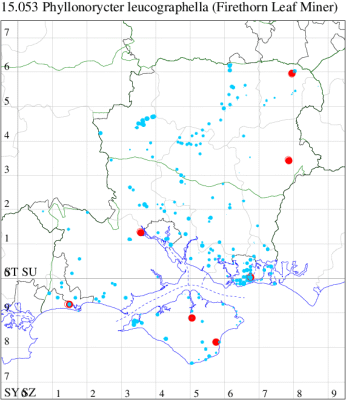
Records by year
Records by week (adult)
Records by week (larval)
Record Details
VC10: Shide, larva, one, field observation, leaf mine in Firethorn, 30 Oct; Shanklin, mine, one, occupied mine in Orchard Apple, 01 Sep (IOu);
VC11: Totton, one, 08 Sep (LH); Portsmouth, one, 07 May (IRT); Tuckton, Bournemouth, one, 20 May; one, 14 Sep (APar);
VC12: Cholderton, one, 31 Jul (TJN, HE); one, field observation, 22 Aug (TJN, LF); Harestock, one, to actinic, 21 Jul; one, to actinic, 10 Aug (GRog); Whitehill*, larva, three, field observation, 17 Oct (ASto); Castle Bottom NNR, one, netted, ♀, gen det, 18 May (JHH det. AMD)
15.054 [B&F: 0333] Phyllonorycter salictella (Zeller, 1846) - Common
Common in marshes, river-banks and other damp areas in England and Wales, with scattered records in Scotland; rare in Ireland. In Hampshire and on the Isle of Wight locally common in the south-east of the county and around Fleet, and probably under-recorded elsewhere. Wingspan 7.5-8 mm. Imago fairly regular at light, but more frequently recorded in the larval stage, when mines are relatively easy to find where they are present. Larva mines leaves of smooth-leaved Salix species, such as Osier and Crack Willow, has also been recorded on Aspen, over-wintering as a pupa in a cocoon.
Records prior to 2020
| Vice County | #Records | #Individuals | First Record | Last Record |
|---|---|---|---|---|
| 10 | 17 | 6 | 1900 | 2013 |
| 11 | 136 | 74 | 1968 | 2019 |
| 12 | 24 | 7 | 1980 | 2019 |
2020 records
| Vice County | #Records | #Individuals | Max Quantity |
|---|---|---|---|
| 11 | 13 | 4 | 1 |
| 12 | 2 | 2 | 2 |
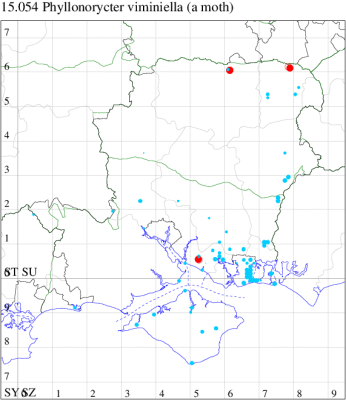
Records by year
Records by week (adult)
Records by week (larval)
Record Details
VC11: Abshott, mine, present, on Salix, 17 Dec (DWal); Baffins, Portsmouth, mine, one, Salix cinerea, 24 Nov; Portsmouth, mine, present, many, Salix caprea, S. cinerea, 23 Oct; mine, present, a few, Salix cinerea, 24 Nov; Milton Common, mine, present, a few, Salix fragilis, 19 Oct (JRL, IRT); Southsea, mine, present, a few, Salix cinerea, 22 Oct (JRL);
VC12: Pamber Forest, mine, present, on crack willow, 17 Oct (GJD); Up Green Wood, Eversley*, two, netted, ♂, gen det, 07 May (JHH det. AMD)
15.057 [B&F: 0336] Phyllonorycter dubitella (Herrich-Schäffer, 1855) - Nationally Scarce B
Nationally scarce (Nb) in woodland, scrub and river-banks in parts of south-eastern England, with records north to Lancashire. The first British record was made in 1969 by the late D.W.H. Ffennell, who found mines in the leaves of Goat Willow along the Winchester by-pass. In Hampshire still rare, mostly in the south-east of the county. First recorded on the Isle of Wight in 1977 and again at Bouldnor in 2001, but not since. Wingspan 7-8 mm. Similar to P. salicicolella, which see for differences; weakly marked specimens resemble P. salictella in shape and colouring but the strigulae are more distinct (MBGBI Vol 2). Imago comes to light, but just as likely to be recorded in the larval stage, when mines are relatively easy to find where they are present. Larva mines leaves of Goat Willow, over-wintering as a pupa in a cocoon.
Records prior to 2020
| Vice County | #Records | #Individuals | First Record | Last Record |
|---|---|---|---|---|
| 10 | 1 | 1 | 1977 | 1977 |
| 11 | 42 | 25 | 1969 | 2019 |
| 12 | 7 | 1 | 1975 | 2019 |
2020 records
| Vice County | #Records | #Individuals | Max Quantity |
|---|---|---|---|
| 11 | 7 | 3 | 3 |
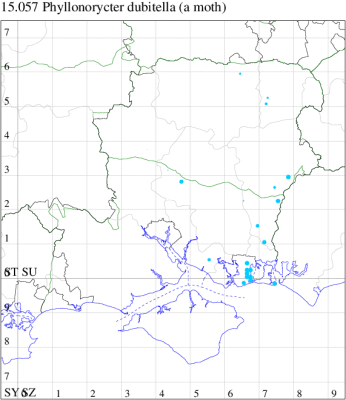
Records by year
Records by week (adult)
Records by week (larval)
Record Details
VC11: Portsmouth, mine, present, several, Salix caprea, 23 Oct; Milton Common, mine, present, a few, Salix caprea, 19 Oct (JRL, IRT)
15.058 [B&F: 0337] Phyllonorycter hilarella (Zetterstedt, 1839) - Common
Common in woodland edges and woodland rides throughout the British Isles. In Hampshire and on the Isle of Wight a generally rather uncommon species. Wingspan 7-9 mm. Imago can be separated from several very similar Phyllonorycter species only by dissection of the genitalia, and much more frequently recorded in the larval stage, when mines are relatively easy to find where they are present. Larva mines leaves of Goat Willow, over-wintering as a pupa in a cocoon.
Records prior to 2020
| Vice County | #Records | #Individuals | First Record | Last Record |
|---|---|---|---|---|
| 10 | 9 | 13 | 1972 | 2013 |
| 11 | 18 | 9 | 1973 | 2018 |
| 12 | 19 | 12 | 1974 | 2019 |
2020 records
| Vice County | #Records | #Individuals | Max Quantity |
|---|---|---|---|
| 11 | 1 | 1 | 1 |
| 12 | 1 | 1 | 1 |
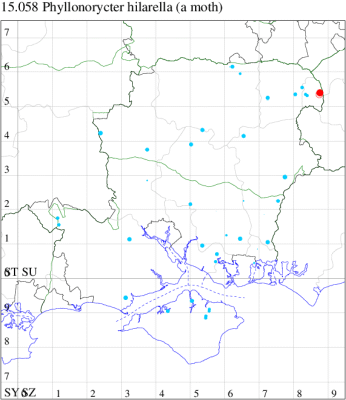
Records by year
Records by week (adult)
Records by week (larval)
Record Details
VC11: Eastleigh*, one, to actinic, 09 Aug (KArb);
VC12: Farnborough, one, 30 Jul (KBW)
15.060 [B&F: 0339] Phyllonorycter ulicicolella (Stainton, 1851) - Nationally Scarce B
Nationally scarce (Nb) on heathland, downland and grassland in the coastal counties of southern England, from Norfolk to Cornwall, and north-western England. In Hampshire recorded sparsely in both vice counties; first recorded from the Isle of Wight in 2020. Wingspan 6-7 mm. May be obtained by beating gorse bushes, it is seldom seen except as an adult. Larva mines spines of Gorse.
Records prior to 2020
| Vice County | #Records | #Individuals | First Record | Last Record |
|---|---|---|---|---|
| 11 | 11 | 8 | 1989 | 2009 |
| 12 | 4 | 3 | 1996 | 2005 |
2020 records
| Vice County | #Records | #Individuals | Max Quantity |
|---|---|---|---|
| 10 | 4 | 19 | 9 |
| 12 | 1 | 1 | 1 |
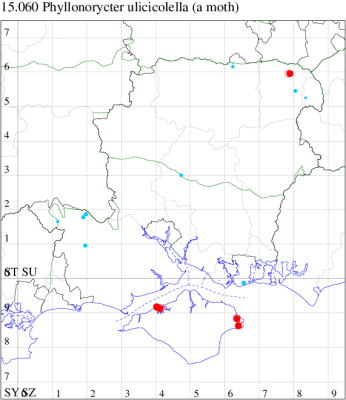
Records by year
Records by week (adult)
Records by week (larval)
Record Details
VC10: New Vice-county Record: Hampstead*, mine, two, mines on young shoots of Ulex europaea, 23 Sep; mine, four, mines on young shoots of Ulex europaea, 23 Sep; St Helens*, mine, nine, on young shoots of Ulex europaea, 19 Sep; Whitecliff Bay*, mine, four, on young shoots of Ulex europaea, 01 Oct (PBa);
VC12: Eversley Common*, mine, one, occupied mine on Ulex europaea, 29 Dec (JHH)
15.061 [B&F: 0340] Phyllonorycter scopariella (Zeller, 1846) - Nationally Scarce B
Nationally scarce (Nb) on heathland and in open woodland throughout much of the British Isles, but difficult to locate either as an adult or in the larval stage. In Hampshire found at just a few sites in the north and south, but likely to be far more widely distributed than the records suggest. Not recorded from the Isle of Wight to date. Wingspan 6-8 mm. According to MBGBI Vol 2, it is seldom encountered except as an adult, however the majority of records in Hampshire are in the larval stage. Larva mines twigs of Broom.
Records prior to 2020
| Vice County | #Records | #Individuals | First Record | Last Record |
|---|---|---|---|---|
| 11 | 4 | 4 | 1974 | 2018 |
| 12 | 6 | 6 | 1976 | 2010 |
2020 records
| Vice County | #Records | #Individuals | Max Quantity |
|---|---|---|---|
| 12 | 1 | 2 | 2 |
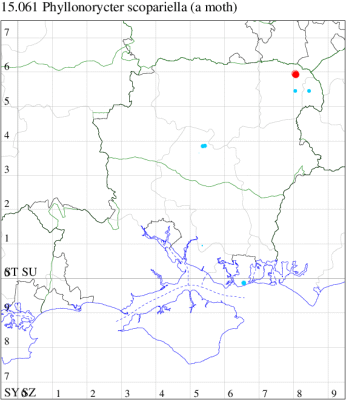
Records by year
Records by week (adult)
Records by week (larval)
Record Details
VC12: Blackbushe Airfield, vacated mine, two, 1 old mine (brownish) & 1 seemingly fresh, but empty, mine on Broom, 30 Dec (JHH)
15.063 [B&F: 0341] Phyllonorycter maestingella (Müller, 1764) - Common
Common in deciduous woodland throughout the British Isles. Widespread and common in Hampshire and on the Isle of Wight, wherever there is Beech. Wingspan 7.5-9 mm. More frequently recorded in the larval stage, when the mines are often easy to find in suitable habitat; the imago can be separated from other similar Phyllonorycter species only by dissection of the genitalia. Larva mines leaves of Beech, over-wintering as a pupa in a cocoon.
Records prior to 2020
| Vice County | #Records | #Individuals | First Record | Last Record |
|---|---|---|---|---|
| 10 | 68 | 42 | 1949 | 2018 |
| 11 | 344 | 568 | 1972 | 2019 |
| 12 | 140 | 42 | 1973 | 2019 |
2020 records
| Vice County | #Records | #Individuals | Max Quantity |
|---|---|---|---|
| 10 | 1 | 0 | 0 |
| 11 | 5 | 60 | 50 |
| 12 | 4 | 4 | 3 |
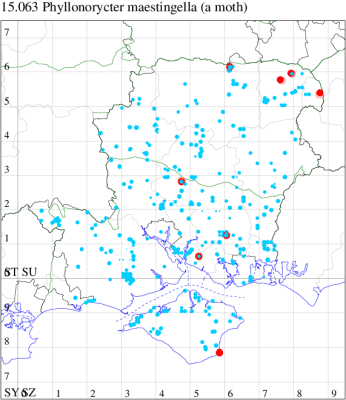
Records by year
Records by week (adult)
Records by week (larval)
Record Details
VC10: Bonchurch Landslip, mine, present, vacated tentiform mine in Beech leaf, 10 Sep (IOu);
VC11: Winchester, one, 14 Jul (THW); Titchfield Common, mine, three, on beech, 10 Dec (DWal); West Walk, mine, five, 5+ tenanted mines on beech undersides, 23 Jun; mine, 50, many mines on beech (underside of leaf), 06 Jul (RJD);
VC12: Pamber Forest, vacated mine, present, in beech leaves, 18 Oct (GJD); Hazeley Heath, vacated mine, three, on Beech (Fagus sylvatica), 16 Nov; Castle Bottom NNR, larva, present, field observation, occupied mine on Beech (Fagus sylvatica), 13 Nov (JHH); Farnborough, one, 30 Jul (KBW)
15.064 [B&F: 0342] Nut Leaf Blister Moth Phyllonorycter coryli (Nicelli, 1851) - Common
Common in woodland, scrub and hedgerows throughout much of the British Isles, except for the Northern Isles. In Hampshire and on the Isle of Wight abundant wherever hazel occurs. Wingspan 7-8.5 mm. Imago rarely comes to light, and more frequently recorded in the larval stage, when mines are relatively easy to find where they are present. Larva mines leaves of Hazel, over-wintering as a pupa in a cocoon.
Records prior to 2020
| Vice County | #Records | #Individuals | First Record | Last Record |
|---|---|---|---|---|
| 10 | 175 | 375 | 1950 | 2019 |
| 11 | 367 | 1161 | 1969 | 2019 |
| 12 | 188 | 28 | 1971 | 2019 |
2020 records
| Vice County | #Records | #Individuals | Max Quantity |
|---|---|---|---|
| 10 | 8 | 7 | 4 |
| 11 | 7 | 23 | 10 |
| 12 | 3 | 0 | 0 |
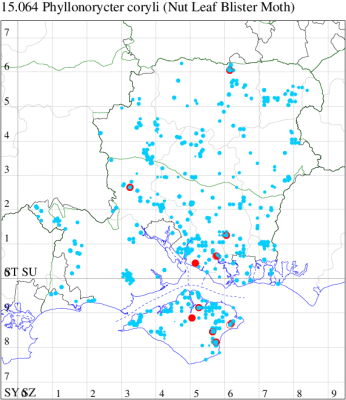
Records by year
Records by week (adult)
Records by week (larval)
Record Details
VC10: Pan, mine, present, 05 Sep; Borthwood Copse, Winford, mine, present, abundant mines in Hazel leaves, 13 Sep; Shanklin, one, gen det, 14 May; one, 18 May; four, gen det, 21 May; one, gen det, 17 Jul (IOu); Wootton, mine, present, upper surface mines on Corylus avellana leaves, 13 Sep; Brading, mine, present, upper surface blister mines common on leaves of Corylus avellana, 19 Sep (PBa);
VC11: Mottisfont Abbey, mine, five, several mines on hazel, 01 Oct (RJD); Chilling, mine, present, several mines on hazel, 04 Dec (DWal); Fareham, vacated mine, one, on Hazel, 10 Dec (MLO); West Walk, mine, five, 5+ tenanted mines of various stages in development on hazel uppersides, 23 Jun; mine, two, fully formed mines on hazel (upperside of leaf), 06 Jul; mine, 10, mines in various stages of development in hazel leaves (upperside), 28 Sep (RJD);
VC12: Pamber Forest, mine, present, abundant on hazel, 17 Oct (GJD)
15.065 [B&F: 0343] Phyllonorycter esperella (Goeze, 1783) - Local
Local in woodland in south-east England up to Northamptonshire, with isolated records elsewhere from the south-west and Welsh borders (MBGBI Vol 2). Probably under-recorded in Hampshire, where the extent of known records correlate with those areas in which the recording effort is concentrated, with the first record from the Isle of Wight coming in 1996. Wingspan 7.5-9 mm. Imago not often seen at light, and more frequently recorded in the larval stage, when mines are relatively easy to find where they are present; in Hampshire and on the Island, almost all records are of the leaf mines, hence the sparseness of the flight-time graph. Larva mines leaves of Hornbeam, over-wintering as a pupa in a cocoon.
Records prior to 2020
| Vice County | #Records | #Individuals | First Record | Last Record |
|---|---|---|---|---|
| 10 | 21 | 7 | 1996 | 2019 |
| 11 | 48 | 38 | 1975 | 2019 |
| 12 | 35 | 62 | 1989 | 2019 |
2020 records
| Vice County | #Records | #Individuals | Max Quantity |
|---|---|---|---|
| 10 | 3 | 0 | 0 |
| 12 | 1 | 0 | 0 |
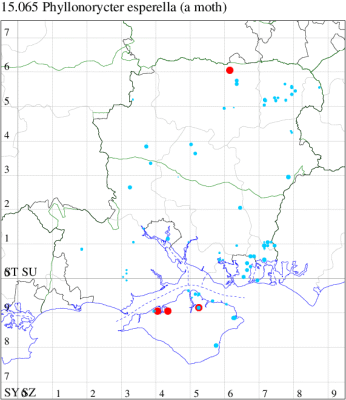
Records by year
Records by week (adult)
Records by week (larval)
Record Details
VC10: Cranmore, mine, present, several upper surface mines onleaves of Carpinus betulusa, 23 Sep; Walter's Copse, Newtown, mine, present, several upper surface mines on leaves of Carpinus betulusa, 15 Sep; Wootton, mine, present, several upper surface mines on Carpinus betulusa, 13 Sep (PBa);
VC12: Pamber Forest*, vacated mine, present, in hornbeam leaves, many mines, 24 Oct (GJD)
15.067 [B&F: 0345] Phyllonorycter rajella (Linnaeus, 1758) - Common
Common in damp woodland throughout much of the British Isles. In Hampshire and on the Isle of Wight apparently well-distributed, but like many leaf miners, probably under-recorded in north Hampshire away from the M3 corridor, and in the New Forest. Wingspan 7-9 mm. Imago does not readily come to light, and more frequently recorded in the larval stage, when mines are relatively easy to find where they are present. Larva mines leaves of Alder and Italian Alder, over-wintering as a pupa in a cocoon.
Records prior to 2020
| Vice County | #Records | #Individuals | First Record | Last Record |
|---|---|---|---|---|
| 10 | 37 | 13 | 1937 | 2016 |
| 11 | 112 | 35 | 1973 | 2019 |
| 12 | 58 | 8 | 1981 | 2019 |
2020 records
| Vice County | #Records | #Individuals | Max Quantity |
|---|---|---|---|
| 11 | 2 | 2 | 1 |
| 12 | 2 | 0 | 0 |
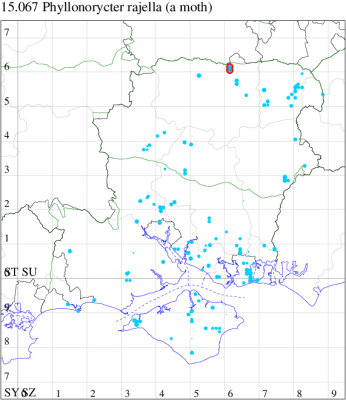
Records by year
Records by week (adult)
Records by week (larval)
Record Details
VC11: Baffins, Portsmouth, mine, one, Alnus glutinosa, 24 Nov (JRL, IRT);
VC12: Pamber Forest, vacated mine, present, on Alder, 17 Oct; mine, present, many mines in a leaf of alder, 18 Oct (GJD)
15.069 [B&F: 0347] Phyllonorycter anderidae (Fletcher, 1885) - Nationally Scarce B
Nationally scarce (Nb) on heathland, moorland and mosses in southern and south-eastern counties of England, a number of north Welsh and adjacent English counties to Cumbria, and from west Perthshire (MBGBI Vol 2). In Hampshire known from about a dozen sites in the south, including Emer Bog, Havant Thicket, Roydon Woods and Wickham Common less widespread in the north, where known from Bramshott Common Eelmoor Marsh, Pamber Forest and Yateley Heath Wood. Not recorded from the Isle of Wight to date. Wingspan 5-6.5 mm. Imago seldom encountered, and more likely to be recorded in the larval stage, but mines are small and not particularly easy to find. Larva mines leaves of Birch, with a preference shown for seedling plants growing in open areas such as beside paths or in clearings, tending to disappear from localities when the habitat becomes unsuitable, over-wintering as a pupa in a cocoon.
Records prior to 2020
| Vice County | #Records | #Individuals | First Record | Last Record |
|---|---|---|---|---|
| 11 | 27 | 5 | 1968 | 2009 |
| 12 | 9 | 2 | 1970 | 2009 |
2020 records
| Vice County | #Records | #Individuals | Max Quantity |
|---|---|---|---|
| 12 | 1 | 0 | 0 |
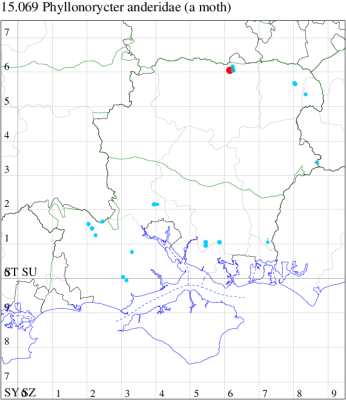
Records by year
Records by week (adult)
Records by week (larval)
Record Details
VC12: Pamber Forest, mine, present, on birch leaves, 17 Oct (GJD)
15.073 [B&F: 0351] Phyllonorycter lautella (Zeller, 1846) - Local
Local in woodland and areas with scattered oaks throughout much of the British Isles. In Hampshire and on the Isle of Wight widespread and locally common, but perhaps under-recorded in the north of the county away from the M3 corridor. Wingspan 6-7 mm. Larva mines leaves of Oak, preferring the foliage of saplings and stooled oaks, over-wintering as a pupa in a cocoon.
Records prior to 2020
| Vice County | #Records | #Individuals | First Record | Last Record |
|---|---|---|---|---|
| 10 | 13 | 9 | 1900 | 2013 |
| 11 | 74 | 60 | 1974 | 2015 |
| 12 | 42 | 6 | 1958 | 2019 |
2020 records
| Vice County | #Records | #Individuals | Max Quantity |
|---|---|---|---|
| 12 | 1 | 0 | 0 |
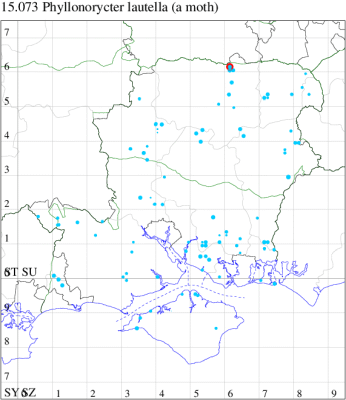
Records by year
Records by week (adult)
Records by week (larval)
Record Details
VC12: Pamber Forest, vacated mine, present, many mines on one oak leaf, 18 Oct (GJD)
15.074 [B&F: 0352] Phyllonorycter schreberella (Fabricius, 1781) - Common
Common in hedgerows throughout much of England and Wales. Reasonably common in south-east Hampshire and on the Isle of Wight, but elsewhere in the county distinctly uncommon. Wingspan 6.5-7.5 mm. Almost always recorded in the larval stage, when the mines are fairly easy to find where they are present, the adult can be separated from other similar Phyllonorycter species on external features only with great care. Larva mines leaves of Elm, over-wintering as a pupa in a cocoon.
Records prior to 2020
| Vice County | #Records | #Individuals | First Record | Last Record |
|---|---|---|---|---|
| 10 | 51 | 39 | 1900 | 2019 |
| 11 | 65 | 14 | 1976 | 2019 |
| 12 | 29 | 9 | 1980 | 2011 |
2020 records
| Vice County | #Records | #Individuals | Max Quantity |
|---|---|---|---|
| 10 | 1 | 1 | 1 |
| 12 | 1 | 0 | 0 |
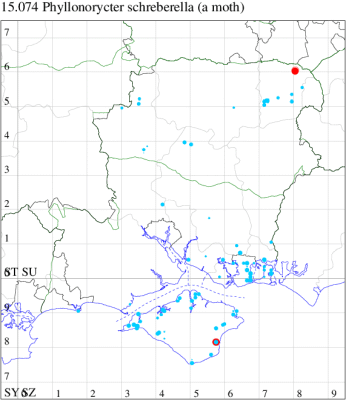
Records by year
Records by week (adult)
Records by week (larval)
Record Details
VC10: Shanklin, one, 14 Aug (IOu);
VC12: Yateley*, larva, present, field observation, occupied mine on English Elm (Ulmus procera), 14 Nov (JHH)
15.075 [B&F: 0353] Phyllonorycter ulmifoliella (Hübner, [1817]) - Common
Widespread and common in birch woodland, with most records being of the leaf mine. Wingspan 7-9mm. Forewing golden-brown, with four costal and three dorsal white strigulae, dark edged inwardly, with a white dark-edged basal streak to one-third. The first pair of strigulae meet to form a slightly curved fascia; dorsal strigulae 2 and 3 lie between the remaining three costal marks, the second pair nearly meeting to form a second fascia, as can the third pair. Sometimes has a pale dorsal patch between the base and the first fascia.
The larva mines the underside of Birch leaves; a small mine, 8-14mm long, causing the upperside to appear dried-up and brownish, the underside with several folds which coalesce to give the appearance of a larger central fold. The leaf is often contorted and curves downwards. Mines can be found in June/July and more plentifully during autumn.
Records prior to 2020
| Vice County | #Records | #Individuals | First Record | Last Record |
|---|---|---|---|---|
| 10 | 35 | 40 | 1937 | 2018 |
| 11 | 271 | 106 | 1968 | 2019 |
| 12 | 87 | 46 | 1975 | 2019 |
2020 records
| Vice County | #Records | #Individuals | Max Quantity |
|---|---|---|---|
| 11 | 2 | 11 | 10 |
| 12 | 7 | 5 | 1 |
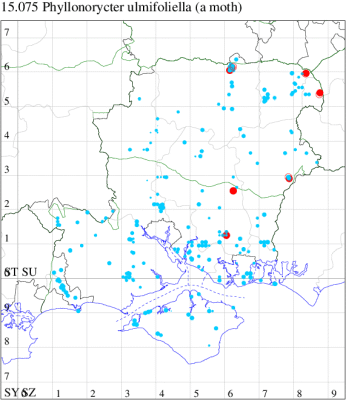
Records by year
Records by week (adult)
Records by week (larval)
Record Details
VC11: West Walk, mine, 10, tenanted mines on birch (undersides), moths bred, 06 Jul (RJD); West Meon, one, ♂, gen det, 31 Jul (F.M.G.);
VC12: Pamber Forest, mine, present, on birch leaves, 17 Oct; one, 24 Jul; one, 15 Aug (GJD); Liss Forest, one, gen det, 10 Apr (RJM); Yateley Common, vacated mine, present, on Birch (Betula pendula), 15 Nov (JHH); Farnborough, one, 25 Jun (KBW)
15.076 [B&F: 0354] Phyllonorycter emberizaepenella (Bouché, 1834) - Local
Local, in woodland, scrub and hedgerows, throughout Britain, rarely in Ireland. In Hampshire and on the Isle of Wight, just about annual, but very rare away from the coast, where recorded in recent years only from Fleet and in the Itchen Valley, although possibly under-recorded. Wingspan 9-10mm. Forewing has a ground colour of light brown. There are four costal and five dorsal white strigulate, the first two pairs meeting to form distinct fascia, the first of which is irregular and varying in width, and the second pair form an obtuse angled or smooth outward-facing fascia; the third pair nearly meet at an acute angle; the fourth pair are opposite and separated from the third by a small patch of dark brown scales; dorsal 5 is immediately below apical patch. The basal streak is short and sinuate, reaching first fascia, and fascia are lightly edged with brown.
The larva mines leaves of Honeysuckle and Snowberry, forming a very large mine underside the leaf: the lower epidermis is gathered into strong folds puckering the leaf, but it does not twist as per P. trifasciella. The moth is bivoltine, generally flying in spring and late summer.
All information from MoGBI Vol.2
Records prior to 2020
| Vice County | #Records | #Individuals | First Record | Last Record |
|---|---|---|---|---|
| 10 | 12 | 8 | 1920 | 2017 |
| 11 | 14 | 5 | 1970 | 2014 |
| 12 | 10 | 5 | 1940 | 2010 |
2020 records
| Vice County | #Records | #Individuals | Max Quantity |
|---|---|---|---|
| 10 | 1 | 0 | 0 |
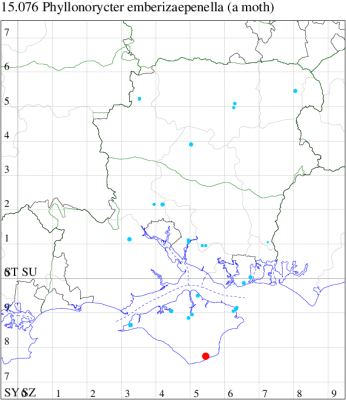
Records by year
Records by week (adult)
Records by week (larval)
Record Details
VC10: Ventnor, mine, present, three mines collected, one tenated, larva bright yellow, 16 Oct (IOu)
15.078 [B&F: 0356] Phyllonorycter tristrigella (Haworth, 1828) - Common
Common in hedgerows in England and Wales. In Hampshire mines are widespread and common on Elm in both vice-counties, and evidently also widespread on the Isle of Wight. Wingspan 7.5-8.5 mm. Imago differs from P. stettinensis, P. froelichiella, P. nicellii and P. kleemannella in having the white pattern much less metallic and its black edging fading more evenly into the ground colour. Imago seldom encountered at light, and more likely to be recorded in the larval stage, when mines are relatively easy to find where they are present. Larva mines leaves of Wych Elm, English Elm and Small-leaved Elm, over-wintering as a pupa in a cocoon.
Records prior to 2020
| Vice County | #Records | #Individuals | First Record | Last Record |
|---|---|---|---|---|
| 10 | 60 | 49 | 1977 | 2017 |
| 11 | 109 | 34 | 1972 | 2019 |
| 12 | 35 | 15 | 1993 | 2017 |
2020 records
| Vice County | #Records | #Individuals | Max Quantity |
|---|---|---|---|
| 10 | 3 | 0 | 0 |
| 11 | 2 | 0 | 0 |
| 12 | 1 | 1 | 1 |
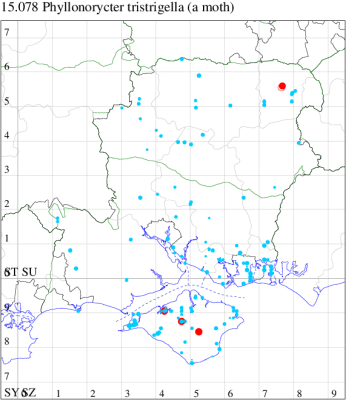
Records by year
Records by week (adult)
Records by week (larval)
Record Details
VC10: Plaish, mine, present, several on Elm, 26 Sep; Newtown, mine, present, several on Elm, 26 Sep; Merstone, mine, present, several on Elm, 27 Sep (KRy);
VC11: Milton, mine, present, many, Ulmus sp., 06 Feb; mine, present, many,Ulmus sp., 06 Nov (JRL, IRT);
VC12: Hartley Wintney, vacated mine, one, on Elm (Ulmus procera), 16 Nov (JHH)
15.079 [B&F: 0357] Phyllonorycter stettinensis (Nicelli, 1852) - Common
Common in damp woodland throughout much of England and Wales, and parts of western Scotland. Probably under-recorded in Hampshire or on the Isle of Wight, where the extent of known records correlate with those areas in which the recording effort is concentrated. Wingspan 6.5-7.5 mm. Imago similar to P. tristrigella, P. froelichiella, P. nicellii and P. kleemannella, but the only one of the group to have a blackish brown vertical tuft on the head. P. stettinensis may also be distinguished by its short basal streak; P. tristrigella usually has a pale basal spot, but the other species no indication even of this (MBGBI Vol 2). Imago seldom encountered at light, and more likely to be recorded in the larval stage, when mines are relatively easy to find where they are present. Larva mines leaves of Alder, over-wintering as a pupa in a cocoon.
Records prior to 2020
| Vice County | #Records | #Individuals | First Record | Last Record |
|---|---|---|---|---|
| 10 | 26 | 13 | 1977 | 2019 |
| 11 | 98 | 41 | 1973 | 2019 |
| 12 | 34 | 12 | 1981 | 2018 |
2020 records
| Vice County | #Records | #Individuals | Max Quantity |
|---|---|---|---|
| 11 | 1 | 0 | 0 |
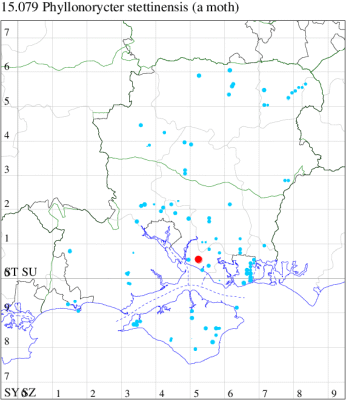
Records by year
Records by week (adult)
Records by week (larval)
Record Details
VC11: Abshott, mine, present, on alder, 17 Dec (DWal)
15.080 [B&F: 0358] Phyllonorycter froelichiella (Zeller, 1839) - Common
Common in damp woodland throughout much of Britain, but in Ireland known only from the Burren. Probably under-recorded in Hampshire and on the Isle of Wight, where the extent of known records correlate with those areas in which the recording effort is concentrated. Wingspan 9-10 mm. Imago similar to P. stettinensis, P. tristrigella, P. nicellii and P. kleemannella, but is by far the largest species in the group, its copper-brown ground colour is characteristic, it has the narrowest and most sharply defined black edging to the white markings and the first pair of strigulae are smoothly curved distad with their apices almost touching to form an acute- or right-angled chevron (MBGBI Vol 2). Imago seldom encountered at light, and more likely to be recorded in the larval stage, when mines are relatively easy to find where they are present. Larva mines leaves of Alder, over-wintering as a pupa in a cocoon.
Records prior to 2020
| Vice County | #Records | #Individuals | First Record | Last Record |
|---|---|---|---|---|
| 10 | 13 | 13 | 1937 | 2017 |
| 11 | 59 | 21 | 1972 | 2018 |
| 12 | 31 | 8 | 1977 | 2019 |
2020 records
| Vice County | #Records | #Individuals | Max Quantity |
|---|---|---|---|
| 11 | 2 | 1 | 1 |
| 12 | 4 | 6 | 3 |
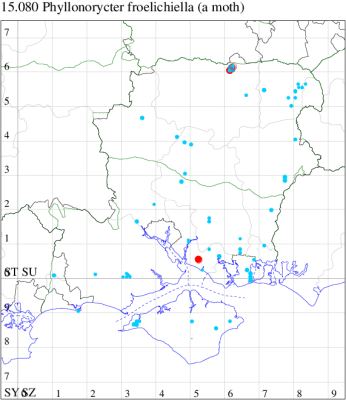
Records by year
Records by week (adult)
Records by week (larval)
Record Details
VC11: Abshott, mine, present, on alder, 17 Dec (DWal); Baffins, Portsmouth, mine, one, Alnus glutinosa, 24 Nov (JRL, IRT);
VC12: Pamber Forest, mine, present, on Alder, 17 Oct; two, 31 Jul; one, 07 Aug; three, 10 Aug (GJD)
15.081 [B&F: 0359] Phyllonorycter nicellii (Stainton, 1851) - Common
Common in woodland throughout much of the British Isles, but more plentiful in the south. In Hampshire and on the Isle of Wight widespread and common. Wingspan 7-8 mm. Imago similar to P. stettinensis, P. tristrigella, P. froelichiella and, especially, P. kleemannella. P. kleemannella and P. nicellii are two of the more difficult of the group to distinguish. P. kleemannella has a deeper orange ground colour, the fasciae are more shining and often bordered inwardly by a broad band of deep coppery brown rather than the brown irroration of P. nicellii; the first pair of strigulae rarely meet. In P. nicellii the first pair of strigulae often touch, forming a third angulated fascia (MBGBI Vol 2). Imago seldom encountered at light, and more likely to be recorded in the larval stage, when mines are relatively easy to find where they are present. Larva mines leaves of Hazel, over-wintering as a pupa in a cocoon.
Records prior to 2020
| Vice County | #Records | #Individuals | First Record | Last Record |
|---|---|---|---|---|
| 10 | 85 | 69 | 1926 | 2019 |
| 11 | 276 | 184 | 1969 | 2019 |
| 12 | 132 | 51 | 1971 | 2019 |
2020 records
| Vice County | #Records | #Individuals | Max Quantity |
|---|---|---|---|
| 10 | 3 | 7 | 5 |
| 11 | 4 | 4 | 1 |
| 12 | 2 | 0 | 0 |
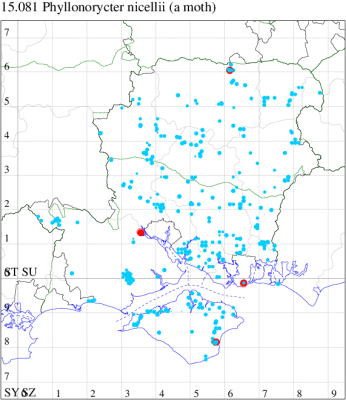
Records by year
Records by week (adult)
Records by week (larval)
Record Details
VC10: Shanklin, five, gen det, 21 May; one, 25 May; one, 26 May (IOu);
VC11: Totton, one, field observation, 22 Apr; one, 30 Jul (LH); Eastleigh, one, to actinic, 08 May (KArb); Southsea, one, 10 Apr (JRL);
VC12: Pamber Forest, vacated mine, present, on Hazel, 17 Oct (GJD)
15.082 [B&F: 0360] Phyllonorycter klemannella (Fabricius, 1781) - Common
Common in damp woodland throughout Britain, except southern Scotland; in Ireland recorded only from Cos Kerry and Wicklow. Probably under-recorded in Hampshire and on the Isle of Wight (where it was first discovered in 1996): the extent of known records correlate with those areas in which the recording effort is concentrated. Wingspan 8 mm. Imago similar to P. stettinensis, P. tristrigella, P. froelichiella and, especially, P. nicellii, which see for differences. Imago seldom encountered at light, and more likely to be recorded in the larval stage, when mines are relatively easy to find where they are present. Larva mines leaves of Alder, over-wintering as a pupa in a cocoon.
Records prior to 2020
| Vice County | #Records | #Individuals | First Record | Last Record |
|---|---|---|---|---|
| 10 | 20 | 13 | 1994 | 2019 |
| 11 | 64 | 42 | 1972 | 2018 |
| 12 | 47 | 18 | 1981 | 2019 |
2020 records
| Vice County | #Records | #Individuals | Max Quantity |
|---|---|---|---|
| 11 | 2 | 2 | 1 |
| 12 | 1 | 1 | 1 |
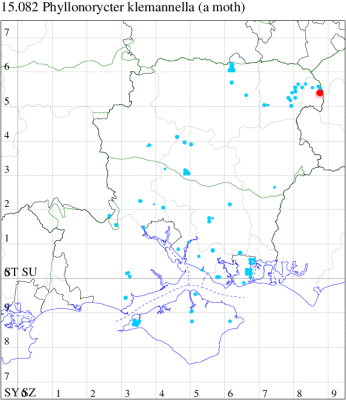
Records by year
Records by week (adult)
Records by week (larval)
Record Details
VC11: Baffins, Portsmouth, mine, one, Alnus glutinosa, 24 Nov (JRL, IRT); Baffins, larva, one, occupied mine on Alnus glutinosa. Em. before February 2021., 24 Nov (IRT);
VC12: Farnborough, one, 10 Aug (KBW)
15.083 [B&F: 0361] Phyllonorycter trifasciella (Haworth, 1828) - Common
Common in woodland and hedgerows throughout England and Wales, more local in Scotland and apparently only coastal in Ireland (MBGBI Vol 2). In Hampshire and on the Isle of Wight common and widespread. Wingspan 7-8 mm. Imago fairly regular at light, but just as likely to be recorded in the larval stage, when mines are relatively easy to find where they are present. Larva mines leaves of Honeysuckle Lonicera periclymenum, but also Leycesteria formosa and Symphoricarpos.
Records prior to 2020
| Vice County | #Records | #Individuals | First Record | Last Record |
|---|---|---|---|---|
| 10 | 67 | 44 | 1900 | 2019 |
| 11 | 321 | 278 | 1972 | 2019 |
| 12 | 52 | 43 | 1974 | 2019 |
2020 records
| Vice County | #Records | #Individuals | Max Quantity |
|---|---|---|---|
| 10 | 3 | 3 | 1 |
| 11 | 3 | 3 | 1 |
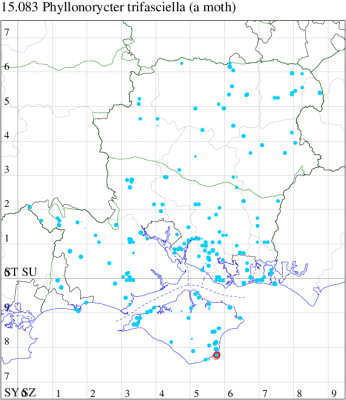
Records by year
Records by week (adult)
Records by week (larval)
Record Details
VC10: Bonchurch, one, 18 Apr; one, 26 Apr; one, 27 Apr (JHa)
15.084 [B&F: 0362] Phyllonorycter acerifoliella (Zeller, 1839) - Common
Common in woodland and hedgerows in south Wales and England, as far north as Derbyshire, with isolated records in Northumberland and Westmorland (MBGBI Vol 2). In Hampshire and on the Isle of Wight common and fairly widespread. Wingspan 8 mm. Imago similar to P. platanoidella, in which the dorsal strigula forming part of the rudimentary first fascia does not nearly touch and make a straight fascia with the second costal strigula as in P. acerifoliella; the second fascia forms an obtuse angle or a smooth curve, whereas in P. acerifoliella it forms an acute or right angle; the yellow-brown coloration of the pattern is deeper than on P. acerifoliella (MBGBI Vol 2). Also similar to P. geniculella, which see for differences. Imago seldom encountered at light, and more likely to be recorded in the larval stage, when mines are relatively easy to find where they are present. Larva mines leaves of Field Maple, over-wintering as a pupa in a cocoon.
Records prior to 2020
| Vice County | #Records | #Individuals | First Record | Last Record |
|---|---|---|---|---|
| 10 | 66 | 30 | 1900 | 2016 |
| 11 | 198 | 111 | 1969 | 2019 |
| 12 | 71 | 16 | 1975 | 2018 |
2020 records
| Vice County | #Records | #Individuals | Max Quantity |
|---|---|---|---|
| 10 | 4 | 1 | 1 |
| 11 | 4 | 2 | 1 |
| 12 | 1 | 0 | 0 |
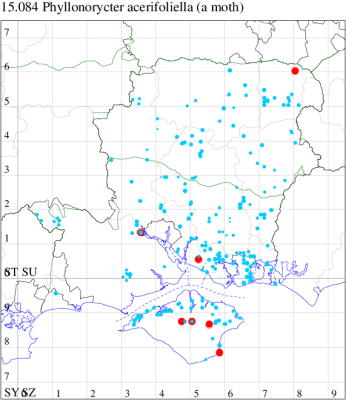
Records by year
Records by week (adult)
Records by week (larval)
Record Details
VC10: Plaish, mine, present, several on field maple, 24 Sep (KRy); Bonchurch Landslip, mine, present, mine with downward fold at edge of Field Maple leaf, 10 Sep; Shide, mine, present, vacated mine with downwards fold at edge of Sycamore leaf, frass at outer edge with silk cocoon to inner edge of mine, 24 Jul (IOu); Mersley, mine, one, mine on underside of Acer campestre leaf, 27 Sep (PBa);
VC11: Totton, one, 22 Aug (LH); Abshott, one, on host-plant, on field maple, 13 Dec (DWal);
VC12: Yateley*, larva, present, field observation, occupied mine on Field Maple (Acer campestre), 14 Nov (JHH)
15.085 [B&F: 0363] Phyllonorycter joannisi (Le Marchand, 1936) - Common
Common in woodland and hedgerows throughout much of south-eastern England and in Worcestershire, but expanding northwards and has recently been found as far north as Yorkshire (MBGBI Vol 2, UKMoths). First discovered in Winchester (vice-county 11) in 1977, spreading to vice-county 12 at Leckford seven years later and the Isle of Wight (vice-county 10) in 2000. Now fairly widespread across both counties, although rare in the New Forest. Wingspan 8 mm. Imago similar to P. acerifoliella and P. geniculella. Imago only occasionally encountered at light, and more likely to be recorded in the larval stage, when mines are relatively easy to find where they are present. Larva monophagous, mining leaves of Norway Maple and over-wintering as a pupa in a cocoon.
Records prior to 2020
| Vice County | #Records | #Individuals | First Record | Last Record |
|---|---|---|---|---|
| 10 | 25 | 17 | 2000 | 2018 |
| 11 | 86 | 112 | 1980 | 2019 |
| 12 | 39 | 14 | 1985 | 2018 |
2020 records
| Vice County | #Records | #Individuals | Max Quantity |
|---|---|---|---|
| 10 | 2 | 3 | 3 |
| 11 | 4 | 4 | 3 |
| 12 | 1 | 1 | 1 |
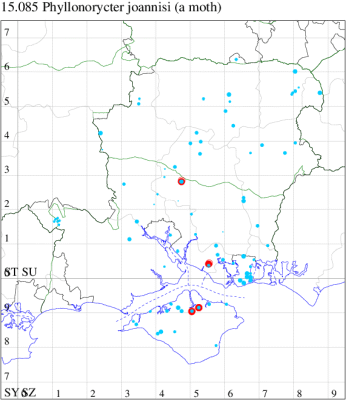
Records by year
Records by week (adult)
Records by week (larval)
Record Details
VC10: Newport, mine, present, several mines on leaves of Acer platanoides, 13 Sep; Wootton, mine, three, on the underside of Acer platanoides leaves, 13 Sep (PBa);
VC11: Winchester, one, 14 Jul (THW); Stubbington, vacated mine, three, on Norway Maple, 01 Nov (DPH det. RJD); Milton, mine, present, many, Acer platanoides, 06 Feb; mine, present, many, Acer platanoides, 06 Nov (JRL, IRT);
VC12: Cholderton, one, 17 Jul (TJN, HE)
15.086 [B&F: 0364] Phyllonorycter geniculella (Ragonot, 1874) - Common
Common in woodland and hedgerows throughout much of Britain, but not in northern Scotland. In Hampshire and on the Isle of Wight fairly well distributed, but perhaps under-recorded in north Hampshire away from the M3 corridor and in the New Forest. Wingspan 8 mm. Similar to P. acerifoliella and P. platanoidella, but differs in having the second chevron sharply angled with its apex extended as a dark-bordered yellow line to the third chevron; the rudimentary first chevron at the base of the wing contains more yellowish brown scales than either of the other two species (MBGBI Vol 2). Imago relatively uncommon at light, and more likely to be recorded in the larval stage, when mines are relatively easy to find where they are present. Larva mines leaves of Sycamore, over-wintering as a pupa in a cocoon.
Records prior to 2020
| Vice County | #Records | #Individuals | First Record | Last Record |
|---|---|---|---|---|
| 10 | 81 | 36 | 1959 | 2018 |
| 11 | 189 | 125 | 1972 | 2019 |
| 12 | 63 | 50 | 1980 | 2018 |
2020 records
| Vice County | #Records | #Individuals | Max Quantity |
|---|---|---|---|
| 10 | 5 | 5 | 2 |
| 11 | 7 | 6 | 2 |
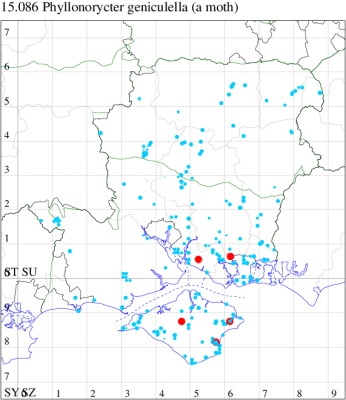
Records by year
Records by week (adult)
Records by week (larval)
Record Details
VC10: Plaish, mine, present, several on sycamore, 26 Sep (KRy); Shanklin, one, 20 Apr; Sibden Hill, pupa, two, field observation, mines in folded edge to Sycamore leaves, containing cocoons with black pupae, 08 Jul; Shanklin, one, gen det, 18 Aug (IOu); Brading, vacated mine, one, underside mine on Acer pseudoplatanus leaf, 19 Sep (PBa);
VC11: Abshott, one, on host-plant, on sycamore, 13 Dec (DWal); Portsdown, two, on host-plant, on sycamore leaf undersides, 14 Sep (RJD); Milton, mine, present, several, Acer pseudoplatanus, 06 Feb; mine, present, several, Acer pseudoplatanus, 06 Nov (JRL, IRT)
15.089 [B&F: 0366a] Cameraria ohridella Deschka & Dimic, 1986 - Common
Common in parks and urban areas throughout much of south-eastern England. An adventive species, first recorded in Europe in Macedonia in 1995, from where it has spread rapidly. In Britain, first recorded in Wimbledon, London in 2002, reaching plague proportions around Greater London and along the Thames Valley by 2006. The first record in Hampshire occurred in 2004, and it appears that it is being dispersed along railway lines and major roads, and now widespread and abundant across much of the county and on the Isle of Wight. Wingspan 8 mm. The larva mines the leaves of Horse Chestnut causing noticeable brown blotches, often many to one leaf, often resulting in complete defoliation of a tree, over-wintering as a pupa in a cocoon. There is however, a similar-looking fungus which can cause confusion.
Records prior to 2020
| Vice County | #Records | #Individuals | First Record | Last Record |
|---|---|---|---|---|
| 10 | 227 | 2674 | 2003 | 2019 |
| 11 | 993 | 14920 | 2004 | 2019 |
| 12 | 533 | 3006 | 2004 | 2019 |
2020 records
| Vice County | #Records | #Individuals | Max Quantity |
|---|---|---|---|
| 10 | 10 | 20 | 10 |
| 11 | 84 | 196 | 35 |
| 12 | 69 | 400 | 90 |
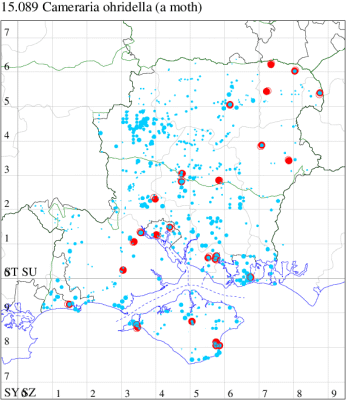
Records by year
Records by week (adult)
Records by week (larval)
Record Summary
VC10: Earliest: Freshwater Bay, 20 Sep, 1 (SDa) Latest: Shanklin Upper Chine, 08 Aug, 1 (IOu) Max count: Shanklin, 29 Apr, 10 (IOu)
VC11: Earliest: Brockenhurst, 17 Oct, 0 (DHow) Latest: Tuckton, Bournemouth, 07 Sep, 2 (APar) Max count: Fareham, 07 Sep, 35 (MLO)
VC12: Earliest: Cholderton, 17 Jul, 1 (TJN, HE) Latest: Yateley, 14 Sep, 1 (JHH) Max count: Farnborough, 08 Sep, 90 (KBW)

(Mine on Ulex europaea)().jpg)
Larva and frass in mine in Ulex europaea)().jpg)
Larva in Ulex europaea)().jpg)